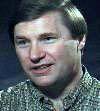Changing ConstantsWe have so far been entertaining the possibility that the distribution of matter, or the rate of expansion of the universe might differ from place to place or on the average. This does not involve ditching any cherished notions of physics. But it is interesting to consider the consequences of a world in which the constants of physics are slightly changed -- either in a hypothetical universe with different true constants or a world (which might be ours) in which they are not all truly constants but either vary from place to place very slowly or have their origins in processes with quasi-random aspects which could have fallen out differently. The first detailed considerations of this sort were made by <!g>Hoyle in 1953 when he recognised that the presence of a significant level of carbon in the universe hinges upon a fine coincidence of physical constants taking values which just allow the carbon nucleus to possess a resonance for the production of carbon from helium, yet just fails to possess a resonance for the reaction that would then burn it all away into oxygen. Later, <!g>Freeman Dyson pointed out the significance of the non-existence of the diproton, helium-2, in Nature. If it did exist then very rapid hydrogen burning would allow stars to race through their evolutionary history, producing black holes and dead relics long before planets could form or life could evolve. Considerations like these, together with the light that superstring
theories have shed upon the origins of the constants of Nature, mean that we
should assess how narrowly defined the existing constants of Nature need to be
in order to permit biochemical complexity to exist in the Universe. We should stress that conclusions regarding the fragility of living
systems with respect to variations in the values of the constants of Nature are
not fully rigorous in all cases. The values of the constants are simply assumed
to take different constant values to those that they are observed to take and the
consequences of changing them one at a time are examined. However, if the
different constants are fully linked together, as we might expect for many of
them if a unified Theory of Everything exists, then many of these independent
variations may not be possible. The consequences of a small change in one
constant would have further necessary ramifications for the allowed values of
other constants. One would expect the overall effect to be more constraining on
the allowed variations that are life-supporting. For examples of such coupled
variations in string theories see refs. These considerations are likely
to have a bearing on interpreting any future quantum cosmological theory. Such
a theory, by its quantum nature, will make probabilistic predictions. It will
predict that it is ‘most probable’ that we find the universe (or its forces and
constants) to take particular values. This presents an interpretational problem
because it is not clear that we should expect the most probable values to be
the ones that we observe. Since only a narrow range of the allowed values for,
say, the fine structure constant will permit observers to exist in the
Universe, we must find ourselves in the narrow range of possibilities which
permit them, no matter how improbable they may be.
Contributed by: Dr. <!g>John Barrow |





